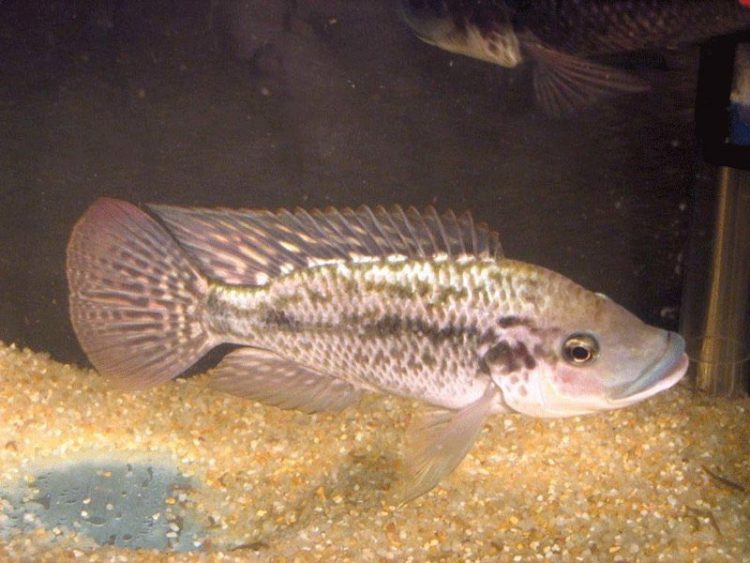Tilapia fish: Ready for mating at the right time

Male Mozambique tilapia (Oreochromis mossambicus). © Olinda G. Almeida / Peter C. Hubbard, Centre of Marine Sciences (CCMAR), Universität der Algarve, Faro, Portugal
The exchange of chemical signals between organisms is considered the oldest form of communication. Acting as messenger molecules, pheromones regulate social interactions between conspecifics, for example, the sexual attraction between males and females. Fish rely on pheromones to trigger social responses and to coordinate reproductive behavior in males and females.
Scientists at the Marine Science Center at the University of the Algarve in Faro, Portugal, and at the Max Planck Institute for Chemical Ecology in Jena, Germany, have now identified such a signal molecule in the urine of male Mozambique tilapia (Oreochromis mossambicus): this pheromone boosts hormone production and accelerates oocyte maturation in reproductive females. Hence, the Mozambique tilapia is one of the first fish species in which the chemical structure of a pheromone has been identified and the biological basis of its activity elucidated.
The social behavior of Mozambique tilapias (Oreochromis mossambicus) native to southern Africa is very complex. The strict hierarchic ranking among males is fought out in so-called courtship arenas. With their mouths, male tilapias make excavations in the sand in the middle of an arena with the aim of attracting females to spawn in these nests.
At the same time, they act aggressively to keep other males away. Dominant males have been observed to urinate more often and squirt larger quantities of urine in the water during fights compared to their subordinate rivals. The urine contains pheromones that reduce aggressive behavior in other males. The compounds also lure females to the nest and modify their hormonal status by accelerating oocyte maturation. Thus the pheromones help to synchronize female spawning and external fertilization by the males and so to increase the odds of reproductive success.
Tilapias also show this behavior in captivity, which makes them an ideal model system for reproducible biological assays. Tina Keller-Costa and her colleagues at the Marine Science Center at the University of the Algarve in Faro, Portugal, as well as the Biosynthesis/NMR Research Group at the Max Planck Institute for Chemical Ecology in Jena, Germany, have now identified the chemical structure of the signaling molecules in tilapia males and studied their function. She collected urine samples from dominant males and purified the samples in several steps, testing them for biological activity as pheromones after each step.
This procedure resulted in two pure substances whose chemical structures were elucidated using nuclear magnetic resonance spectroscopy (NMR). Their identity was confirmed by chemical synthesis: “The two structures are stereoisomers or mirror images of a pregnane-type steroid linked to glucuronic acid,” Bernd Schneider, the head of the NMR lab in Jena, said, summarizing the results of the analysis.
Both males and females showed highly sensitive responses to the odor of these two steroids. Although the two pheromone components stimulate the hormonal system of the females and trigger spawning, they are not by themselves capable of reducing aggressive behavior in rival males. The researchers thus assume that the urine of dominant males must contain additional yet-to-be identified substances that contribute to this effect in a complex mixture.
Until now only very few fish pheromones have been chemically identified. “Our discovery will allow for further investigations, for example, of the mechanisms of perception and processing of these chemical signals by the brain in order to originate a response, in this case oocyte maturation and behavioral changes,” says Tina Keller-Costa, who conducted the experiments for her PhD thesis.
Apart from the carp family, tilapias belong to the most important edible fish raised commercially. However, their aquaculture in many tropical and subtropical waters has led to an uncontrolled population growth and spread of the species. The use of pheromones could help optimize the aquaculture of tilapia species by increasing female fertility and reducing aggression between competing males. Pheromones could also help to control the invasive behavior of these fish, which threatens the ecological balance of many ecosystems.
Contact
Dr. Bernd Schneider
Max Planck Institute for Chemical Ecology, Jena
Phone: +49 3641 57-1600
Angela Overmeyer
Press and Public Relations
Max Planck Institute for Chemical Ecology, Jena
Phone: +49 3641 57-2110
Media Contact
All latest news from the category: Life Sciences and Chemistry
Articles and reports from the Life Sciences and chemistry area deal with applied and basic research into modern biology, chemistry and human medicine.
Valuable information can be found on a range of life sciences fields including bacteriology, biochemistry, bionics, bioinformatics, biophysics, biotechnology, genetics, geobotany, human biology, marine biology, microbiology, molecular biology, cellular biology, zoology, bioinorganic chemistry, microchemistry and environmental chemistry.
Newest articles

Silicon Carbide Innovation Alliance to drive industrial-scale semiconductor work
Known for its ability to withstand extreme environments and high voltages, silicon carbide (SiC) is a semiconducting material made up of silicon and carbon atoms arranged into crystals that is…

New SPECT/CT technique shows impressive biomarker identification
…offers increased access for prostate cancer patients. A novel SPECT/CT acquisition method can accurately detect radiopharmaceutical biodistribution in a convenient manner for prostate cancer patients, opening the door for more…

How 3D printers can give robots a soft touch
Soft skin coverings and touch sensors have emerged as a promising feature for robots that are both safer and more intuitive for human interaction, but they are expensive and difficult…





















